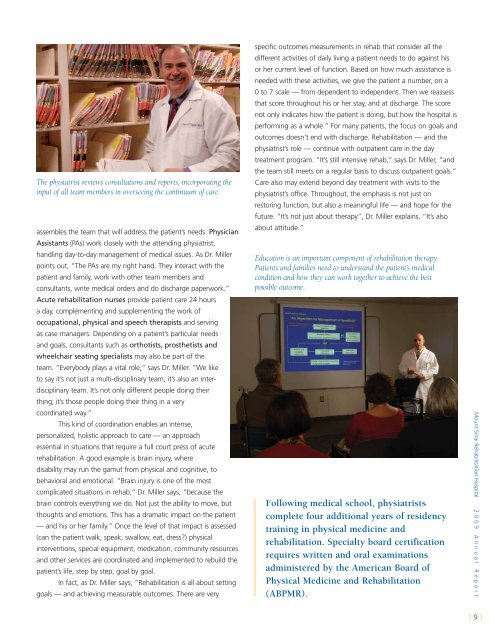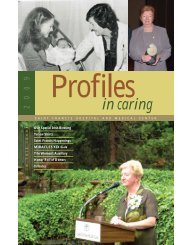2009 Annual Report - Saint Francis Hospital and Medical Center
2009 Annual Report - Saint Francis Hospital and Medical Center
2009 Annual Report - Saint Francis Hospital and Medical Center
You also want an ePaper? Increase the reach of your titles
YUMPU automatically turns print PDFs into web optimized ePapers that Google loves.
The physiatrist reviews consultations <strong>and</strong> reports, incorporating the<br />
input of all team members in overseeing the continuum of care.<br />
assembles the team that will address the patient’s needs. Physician<br />
Assistants (PAs) work closely with the attending physiatrist,<br />
h<strong>and</strong>ling day-to-day management of medical issues. As Dr. Miller<br />
points out, “The PAs are my right h<strong>and</strong>. They interact with the<br />
patient <strong>and</strong> family, work with other team members <strong>and</strong><br />
consultants, write medical orders <strong>and</strong> do discharge paperwork.”<br />
Acute rehabilitation nurses provide patient care 24 hours<br />
a day, complementing <strong>and</strong> supplementing the work of<br />
occupational, physical <strong>and</strong> speech therapists <strong>and</strong> serving<br />
as case managers. Depending on a patient’s particular needs<br />
<strong>and</strong> goals, consultants such as orthotists, prosthetists <strong>and</strong><br />
wheelchair seating specialists may also be part of the<br />
team. “Everybody plays a vital role,” says Dr. Miller. “We like<br />
to say it’s not just a multi-disciplinary team, it’s also an interdisciplinary<br />
team. It’s not only different people doing their<br />
thing; it’s those people doing their thing in a very<br />
coordinated way.”<br />
This kind of coordination enables an intense,<br />
personalized, holistic approach to care — an approach<br />
essential in situations that require a full court press of acute<br />
rehabilitation. A good example is brain injury, where<br />
disability may run the gamut from physical <strong>and</strong> cognitive, to<br />
behavioral <strong>and</strong> emotional. “Brain injury is one of the most<br />
complicated situations in rehab,” Dr. Miller says, “because the<br />
brain controls everything we do. Not just the ability to move, but<br />
thoughts <strong>and</strong> emotions. This has a dramatic impact on the patient<br />
— <strong>and</strong> his or her family.” Once the level of that impact is assessed<br />
(can the patient walk, speak, swallow, eat, dress?) physical<br />
interventions, special equipment, medication, community resources<br />
<strong>and</strong> other services are coordinated <strong>and</strong> implemented to rebuild the<br />
patient’s life, step by step, goal by goal.<br />
In fact, as Dr. Miller says, “Rehabilitation is all about setting<br />
goals — <strong>and</strong> achieving measurable outcomes. There are very<br />
specific outcomes measurements in rehab that consider all the<br />
different activities of daily living a patient needs to do against his<br />
or her current level of function. Based on how much assistance is<br />
needed with these activities, we give the patient a number, on a<br />
0 to 7 scale — from dependent to independent. Then we reassess<br />
that score throughout his or her stay, <strong>and</strong> at discharge. The score<br />
not only indicates how the patient is doing, but how the hospital is<br />
performing as a whole.” For many patients, the focus on goals <strong>and</strong><br />
outcomes doesn’t end with discharge. Rehabilitation — <strong>and</strong> the<br />
physiatrist’s role — continue with outpatient care in the day<br />
treatment program. “It’s still intensive rehab,” says Dr. Miller, “<strong>and</strong><br />
the team still meets on a regular basis to discuss outpatient goals.”<br />
Care also may extend beyond day treatment with visits to the<br />
physiatrist’s office. Throughout, the emphasis is not just on<br />
restoring function, but also a meaningful life — <strong>and</strong> hope for the<br />
future. “It’s not just about therapy”, Dr. Miller explains. “It’s also<br />
about attitude.”<br />
Education is an important component of rehabilitation therapy.<br />
Patients <strong>and</strong> families need to underst<strong>and</strong> the patient’s medical<br />
condition <strong>and</strong> how they can work together to achieve the best<br />
possible outcome.<br />
Following medical school, physiatrists<br />
complete four additional years of residency<br />
training in physical medicine <strong>and</strong><br />
rehabilitation. Specialty board certification<br />
requires written <strong>and</strong> oral examinations<br />
administered by the American Board of<br />
Physical Medicine <strong>and</strong> Rehabilitation<br />
(ABPMR).<br />
Mount Sinai Rehabilitation <strong>Hospital</strong> 2 009 <strong>Annual</strong> <strong>Report</strong><br />
[ 9 ]





